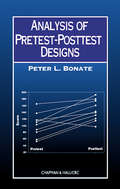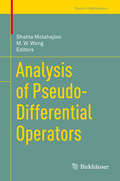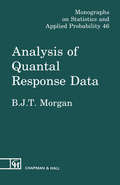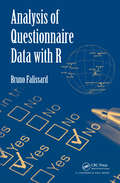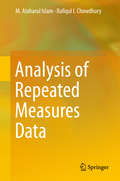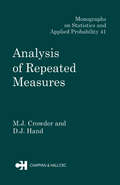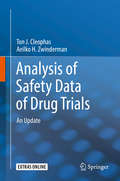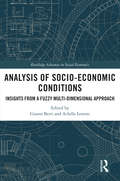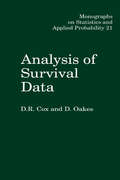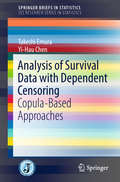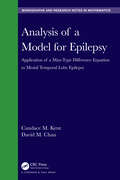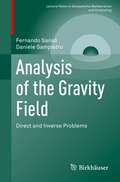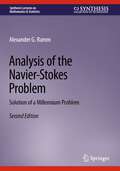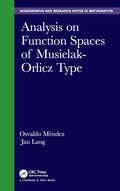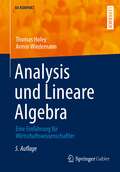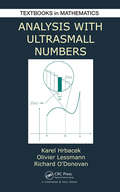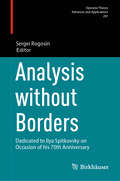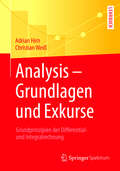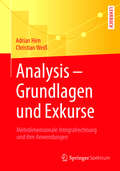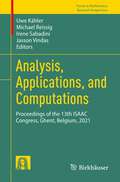- Table View
- List View
Analysis of Pretest-Posttest Designs
by Peter L. BonateHow do you analyze pretest-posttest data? Difference scores? Percent change scores? ANOVA? In medical, psychological, sociological, and educational studies, researchers often design experiments in which they collect baseline (pretest) data prior to randomization. However, they often find it difficult to decide which method of statistical analysis i
Analysis of Pseudo-Differential Operators (Trends in Mathematics)
by M. W. Wong Shahla MolahajlooThis volume, like its predecessors, is based on the special session on pseudo-differential operators, one of the many special sessions at the 11th ISAAC Congress, held at Linnaeus University in Sweden on August 14-18, 2017. It includes research papers presented at the session and invited papers by experts in fields that involve pseudo-differential operators.The first four chapters focus on the functional analysis of pseudo-differential operators on a spectrum of settings from Z to Rn to compact groups. Chapters 5 and 6 discuss operators on Lie groups and manifolds with edge, while the following two chapters cover topics related to probabilities. The final chapters then address topics in differential equations.
Analysis of Quantal Response Data
by Byron J.T. MorganThis book takes the standard methods as the starting point, and then describes a wide range of relatively new approaches and procedures designed to deal with more complicated data and experiments - including much recent research in the area. Throughout mention is given to the computing requirements - facilities available in large computing packages like BMDP, SAS and SPSS are also described.
Analysis of Questionnaire Data with R
by Bruno FalissardWhile theoretical statistics relies primarily on mathematics and hypothetical situations, statistical practice is a translation of a question formulated by a researcher into a series of variables linked by a statistical tool. As with written material, there are almost always differences between the meaning of the original text and translated text.
Analysis of Repeated Measures Data
by M. Ataharul Islam Rafiqul I. ChowdhuryThis book presents a broad range of statistical techniques to address emerging needs in the field of repeated measures. It also provides a comprehensive overview of extensions of generalized linear models for the bivariate exponential family of distributions, which represent a new development in analysing repeated measures data. The demand for statistical models for correlated outcomes has grown rapidly recently, mainly due to presence of two types of underlying associations: associations between outcomes, and associations between explanatory variables and outcomes. The book systematically addresses key problems arising in the modelling of repeated measures data, bearing in mind those factors that play a major role in estimating the underlying relationships between covariates and outcome variables for correlated outcome data. In addition, it presents new approaches to addressing current challenges in the field of repeated measures and models based on conditional and joint probabilities. Markov models of first and higher orders are used for conditional models in addition to conditional probabilities as a function of covariates. Similarly, joint models are developed using both marginal-conditional probabilities as well as joint probabilities as a function of covariates. In addition to generalized linear models for bivariate outcomes, it highlights extended semi-parametric models for continuous failure time data and their applications in order to include models for a broader range of outcome variables that researchers encounter in various fields. The book further discusses the problem of analysing repeated measures data for failure time in the competing risk framework, which is now taking on an increasingly important role in the field of survival analysis, reliability and actuarial science. Details on how to perform the analyses are included in each chapter and supplemented with newly developed R packages and functions along with SAS codes and macro/IML. It is a valuable resource for researchers, graduate students and other users of statistical techniques for analysing repeated measures data.
Analysis of Repeated Measures: A Practical Approach For Behavioural Scientists (Chapman And Hall/crc Monographs On Statistics And Applied Probability Ser. #41)
by David J. Hand Martin J. CrowderRepeated measures data arise when the same characteristic is measured on each case or subject at several times or under several conditions. There is a multitude of techniques available for analysing such data and in the past this has led to some confusion. This book describes the whole spectrum of approaches, beginning with very simple and crude methods, working through intermediate techniques commonly used by consultant statisticians, and concluding with more recent and advanced methods. Those covered include multiple testing, response feature analysis, univariate analysis of variance approaches, multivariate analysis of variance approaches, regression models, two-stage line models, approaches to categorical data and techniques for analysing crossover designs. The theory is illustrated with examples, using real data brought to the authors during their work as statistical consultants.
Analysis of Safety Data of Drug Trials: An Update
by Aeilko H. Zwinderman Ton J. CleophasIn 2010, the 5th edition of the textbook, "Statistics Applied to Clinical Studies", was published by Springer and since then has been widely distributed. The primary object of clinical trials of new drugs is to demonstrate efficacy rather than safety. However, a trial in humans which does not adequately address safety is unethical, while the assessment of safety variables is an important element of the trial.An effective approach is to present summaries of the prevalence of adverse effects and their 95% confidence intervals. In order to estimate the probability that the differences between treatment and control group occurred merely by chance, a statistical test can be performed. In the past few years, this pretty crude method has been supplemented and sometimes, replaced with more sophisticated and better sensitive methodologies, based on machine learning clusters and networks, and multivariate analyses. As a result, it is time that an updated version of safety data analysis was published. The issue of dependency also needs to be addressed. Adverse effects may be either dependent or independent of the main outcome. For example, an adverse effect of alpha blockers is dizziness and this occurs independently of the main outcome "alleviation of Raynaud 's phenomenon". In contrast, the adverse effect "increased calorie intake" occurs with "increased exercise", and this adverse effect is very dependent on the main outcome "weight loss". Random heterogeneities, outliers, confounders, interaction factors are common in clinical trials, and all of them can be considered as kinds of adverse effects of the dependent type. Random regressions and analyses of variance, high dimensional clusterings, partial correlations, structural equations models, Bayesian methods are helpful for their analysis. The current edition was written for non-mathematicians, particularly medical and health professionals and students. It provides examples of modern analytic methods so far largely unused in safety analysis. All of the 14 chapters have two core characteristics, First, they are intended for current usage, and they are particularly concerned with that usage. Second, they try and tell what readers need to know in order to understand and apply the methods. For that purpose, step by step analyses of both hypothesized and real data examples are provided.
Analysis of Socio-Economic Conditions: Insights from a Fuzzy Multi-dimensional Approach (Routledge Advances in Social Economics)
by Gianni Betti and Achille LemmiShowcasing fuzzy set theory, this book highlights the enormous potential of fuzzy logic in helping to analyse the complexity of a wide range of socio-economic patterns and behaviour. The contributions to this volume explore the most up-to-date fuzzy-set methods for the measurement of socio-economic phenomena in a multidimensional and/or dynamic perspective. Thus far, fuzzy-set theory has primarily been utilised in the social sciences in the field of poverty measurement. These chapters examine the latest work in this area, while also exploring further applications including social exclusion, the labour market, educational mismatch, sustainability, quality of life and violence against women. The authors demonstrate that real-world situations are often characterised by imprecision, uncertainty and vagueness, which cannot be properly described by the classical set theory which uses a simple true–false binary logic. By contrast, fuzzy-set theory has been shown to be a powerful tool for describing the multidimensionality and complexity of social phenomena. This book will be of significant interest to economists, statisticians and sociologists utilising quantitative methods to explore socio-economic phenomena.
Analysis of Survival Data
by D.R. CoxThis monograph contains many ideas on the analysis of survival data to present a comprehensive account of the field. The value of survival analysis is not confined to medical statistics, where the benefit of the analysis of data on such factors as life expectancy and duration of periods of freedom from symptoms of a disease as related to a treatment applied individual histories and so on, is obvious. The techniques also find important applications in industrial life testing and a range of subjects from physics to econometrics. In the eleven chapters of the book the methods and applications of are discussed and illustrated by examples.
Analysis of Survival Data with Dependent Censoring: Copula-Based Approaches (SpringerBriefs in Statistics)
by Takeshi Emura Yi-Hau ChenThis book introduces readers to copula-based statistical methods for analyzing survival data involving dependent censoring. Primarily focusing on likelihood-based methods performed under copula models, it is the first book solely devoted to the problem of dependent censoring. <P><P> The book demonstrates the advantages of the copula-based methods in the context of medical research, especially with regard to cancer patients’ survival data. Needless to say, the statistical methods presented here can also be applied to many other branches of science, especially in reliability, where survival analysis plays an important role. <P> The book can be used as a textbook for graduate coursework or a short course aimed at (bio-) statisticians. To deepen readers’ understanding of copula-based approaches, the book provides an accessible introduction to basic survival analysis and explains the mathematical foundations of copula-based survival models.
Analysis of Variance Designs
by Lawrence S. Meyers Glenn Gamst A. J. Guarino Glenn Gamst Lawrence S. MeyersANOVA (Analysis Of Variance) is one of the most fundamental and ubiquitous univariate methodologies employed by psychologists and other behavioural scientists. Analysis of Variance Designs presents the foundations of this experimental design, including assumptions, statistical significance, strength of effect, and the partitioning of the variance. Exploring the effects of one or more independent variables on a single dependent variable as well as two-way and three-way mixed designs, this textbook offers an overview of traditionally advanced topics for advanced undergraduates and graduate students in the behavioural and social sciences. Separate chapters are devoted to multiple comparisons (post hoc and planned/weighted), ANCOVA, and advanced topics. Each of the design chapters contains conceptual discussions, hand calculations, and procedures for the omnibus and simple effects analyses in both SPSS and the new 'click and shoot' SAS Enterprise Guide interface.
Analysis of Variance for Functional Data (Chapman & Hall/CRC Monographs on Statistics and Applied Probability)
by Jin-Ting ZhangDespite research interest in functional data analysis in the last three decades, few books are available on the subject. Filling this gap, Analysis of Variance for Functional Data presents up-to-date hypothesis testing methods for functional data analysis. The book covers the reconstruction of functional observations, functional ANOVA, functional l
Analysis of Variance, Design, and Regression: Linear Modeling for Unbalanced Data, Second Edition (Chapman & Hall/CRC Texts in Statistical Science #121)
by Ronald ChristensenAnalysis of Variance, Design, and Regression: Linear Modeling for Unbalanced Data, Second Edition presents linear structures for modeling data with an emphasis on how to incorporate specific ideas (hypotheses) about the structure of the data into a linear model for the data. The book carefully analyzes small data sets by using tools that are easily scaled to big data. The tools also apply to small relevant data sets that are extracted from big data. New to the Second Edition Reorganized to focus on unbalanced data Reworked balanced analyses using methods for unbalanced data Introductions to nonparametric and lasso regression Introductions to general additive and generalized additive models Examination of homologous factors Unbalanced split plot analyses Extensions to generalized linear models R, Minitab®, and SAS code on the author’s website The text can be used in a variety of courses, including a yearlong graduate course on regression and ANOVA or a data analysis course for upper-division statistics students and graduate students from other fields. It places a strong emphasis on interpreting the range of computer output encountered when dealing with unbalanced data.
Analysis of Variations for Self-similar Processes: A Stochastic Calculus Approach (Probability and Its Applications)
by Ciprian A. TudorSelf-similar processes are stochastic processes that are invariant in distribution under suitable time scaling, and are a subject intensively studied in the last few decades. This book presents the basic properties of these processes and focuses on the study of their variation using stochastic analysis. While self-similar processes, and especially fractional Brownian motion, have been discussed in several books, some new classes have recently emerged in the scientific literature. Some of them are extensions of fractional Brownian motion (bifractional Brownian motion, subtractional Brownian motion, Hermite processes), while others are solutions to the partial differential equations driven by fractional noises. In this monograph the author discusses the basic properties of these new classes of self-similar processes and their interrelationship. At the same time a new approach (based on stochastic calculus, especially Malliavin calculus) to studying the behavior of the variations of self-similar processes has been developed over the last decade. This work surveys these recent techniques and findings on limit theorems and Malliavin calculus.
Analysis of a Model for Epilepsy: Application of a Max-Type Difference Equation to Mesial Temporal Lobe Epilepsy (Chapman & Hall/CRC Monographs and Research Notes in Mathematics)
by Candace M. Kent David M. ChanIn the 1960s and 1970s, mathematical biologists Sir Robert M. May, E.C. Pielou, and others utilized difference equations as models of ecological and epidemiological phenomena. Since then, with or without applications, the mathematics of difference equations has evolved into a field unto itself. Difference equations with the maximum (or the minimum or the "rank-type") function were rigorously investigated from the mid-1990s into the 2000s, without any applications in mind. These equations often involved arguments varying from reciprocal terms with parameters in the numerators to other special functions. Recently, the authors of Analysis of a Model for Epilepsy: Application of a Max-Type Difference Equation to Mesial Temporal Lobe Epilepsy and their colleagues investigated the first known application of a "max-type" difference equation. Their equation is a phenomenological model of epileptic seizures. In this book, the authors expand on that research and present a more comprehensive development of mathematical, numerical, and biological results. Additionally, they describe the first documented instance of a novel dynamical behavior that they call rippled almost periodic behavior, which can be described as an unpredictable pseudo-periodic behavior. Features: Suitable for researchers in mathematical neuroscience and potentially as supplementary reading for postgraduate students Thoroughly researched and replete with references
Analysis of the Gravity Field: Direct and Inverse Problems (Lecture Notes in Geosystems Mathematics and Computing)
by Fernando Sansò Daniele SampietroThis textbook presents a comprehensive treatment of the theory and implementation of inverse methods in the analysis and interpretation of Earth’s gravity field. By restricting their consideration to a local rather than global level, the authors focus on the use of observations and data that are more sensitive to local mass anomalies. All necessary theoretical aspects are reformulated in terms of a Euclidean framework so that less complex tools from mathematical analysis can be utilized.Divided into three parts, the text begins with a review of basic mathematical properties of gravitation, computing gravity from mass distributions, and relevant methods from Fourier analysis. In the second part of the text, the Earth’s gravity field and its properties are introduced, and the preprocessing and processing of gravity data are explored. Finally, elementary inverse theory is discussed, after which the general inversion problem is considered via application of both the Tikhonov deterministic approach and a stochastic MCMC model. Throughout, examples and exercises are provided to both clarify material and to illustrate real-word applications for readers. Analysis of the Gravity Field: Direct and Inverse Problems is carefully written to be accessible to both mathematicians and geophysicists without sacrificing mathematical rigor. Readers should have a familiarity with the basics of mathematical analysis, as well as some knowledge of statistics and probability theory. Detailed proofs of more advanced results are relegated to appendices so that readers can concentrate on solution algorithms.
Analysis of the Navier-Stokes Problem: Solution of a Millennium Problem (Synthesis Lectures on Mathematics & Statistics)
by Alexander G. RammThis book revises and expands upon the prior edition, The Navier-Stokes Problem. The focus of this book is to provide a mathematical analysis of the Navier-Stokes Problem (NSP) in R^3 without boundaries. Before delving into analysis, the author begins by explaining the background and history of the Navier-Stokes Problem. This edition includes new analysis and an a priori estimate of the solution. The estimate proves the contradictory nature of the Navier-Stokes Problem. The author reaches the conclusion that the solution to the NSP with smooth and rapidly decaying data cannot exist for all positive times. By proving the NSP paradox, this book provides a solution to the millennium problem concerning the Navier-Stokes Equations and shows that they are physically and mathematically contradictive.
Analysis on Function Spaces of Musielak-Orlicz Type (Chapman & Hall/CRC Monographs and Research Notes in Mathematics)
by Osvaldo Mendez Jan LangAnalysis on Function Spaces of Musielak-Orlicz Type provides a state-of-the-art survey on the theory of function spaces of Musielak-Orlicz type. The book also offers readers a step-by-step introduction to the theory of Musielak–Orlicz spaces, and introduces associated function spaces, extending up to the current research on the topic Musielak-Orlicz spaces came under renewed interest when applications to electrorheological hydrodynamics forced the particular case of the variable exponent Lebesgue spaces on to center stage. Since then, research efforts have typically been oriented towards carrying over the results of classical analysis into the framework of variable exponent function spaces. In recent years it has been suggested that many of the fundamental results in the realm of variable exponent Lebesgue spaces depend only on the intrinsic structure of the Musielak-Orlicz function, thus opening the door for a unified theory which encompasses that of Lebesgue function spaces with variable exponent. Features Gives a self-contained, concise account of the basic theory, in such a way that even early-stage graduate students will find it useful Contains numerous applications Facilitates the unified treatment of seemingly different theoretical and applied problems Includes a number of open problems in the area
Analysis und Lineare Algebra: Eine Einführung für Wirtschaftswissenschaftler (BA KOMPAKT)
by Thomas Holey Armin WiedemannAnalysis und Lineare Algebra
Analysis with Ultrasmall Numbers (Textbooks in Mathematics)
by Karel Hrbacek Olivier Lessmann Richard O'DonovanAnalysis with Ultrasmall Numbers presents an intuitive treatment of mathematics using ultrasmall numbers. With this modern approach to infinitesimals, proofs become simpler and more focused on the combinatorial heart of arguments, unlike traditional treatments that use epsilon-delta methods. Students can fully prove fundamental results, such as the
Analysis without Borders: Dedicated to Ilya Spitkovsky on Occasion of his 70th Anniversary (Operator Theory: Advances and Applications #297)
by Sergei RogosinThis book is a tribute to the achievements of Ilya Spitkovsky in operator theory, pseudo-differential and integral equations, factorization theory and many other related topics. Ilya Spitkovsky started his career under the guidance of Mark Krein in Odessa, Ukraine. During these years, Ilya’s rigorous and clear style of doing mathematics matured. Since 1990 Ilya Spitkovsky has been a professor of mathematics at the College of William and Mary in Williamsburg, Virginia, where he has taught a wide range of courses, including linear algebra, real, complex, and functional analysis. He has authored more than 300 publications, including four research monographs, and edited eight books of proceedings. Ilya Spitkovsky is currently a member of the editorial board of five international journals. Since 2013 he is a professor of the Division of Science and Mathematics New York University Abu Dhabi, UAE. With this volume, the authors of the articles join the large family of people who congratulate Ilya Spitkovsky on his anniversary. It is their wish that the contributions in this volume offer inspiring insights to researchers working in these fields.
Analysis – Grundlagen und Exkurse: Grundprinzipien der Differential- und Integralrechnung
by Christian Weiß Adrian HirnIn diesem Lehrbuch wird der moderne Lebesguesche Integralbegriff ausf#65533;hrlich entwickelt und auf eine vielf#65533;ltige Klasse von geometrischen Objekten, sogenannte Untermannigfaltigkeiten, #65533;bertragen. Der vorliegende zweite Band richtet den Fokus st#65533;rker auf h#65533;here Dimensionen und stellt zusammen mit dem ersten Band eine umfassende Einf#65533;hrung in die Analysis dar. Die mathematischen Grundlagen werden durch zahlreiche *-Kapitel erweitert, welche die Beziehungen der erlernten Inhalte zu anderen Teilgebieten der Mathematik aufzeigen und die Bedeutung der Analysis f#65533;r praktische Anwendungen verdeutlichen. Dar#65533;ber hinaus enth#65533;lt dieses Buch mehr als 50 #65533;bungsaufgaben inklusive L#65533;sungen, sodass es sich sehr gut f#65533;r Pr#65533;fungsvorbereitungen und zum Selbststudium eignet.
Analysis – Grundlagen und Exkurse: Mehrdimensionale Integralrechnung und ihre Anwendungen
by Christian Weiß Adrian HirnIn diesem Lehrbuch wird der moderne Lebesguesche Integralbegriff ausf#65533;hrlich entwickelt und auf eine vielf#65533;ltige Klasse von geometrischen Objekten, sogenannte Untermannigfaltigkeiten, #65533;bertragen. Der vorliegende zweite Band richtet den Fokus st#65533;rker auf h#65533;here Dimensionen und stellt zusammen mit dem ersten Band eine umfassende Einf#65533;hrung in die Analysis dar. Die mathematischen Grundlagen werden durch zahlreiche *-Kapitel erweitert, welche die Beziehungen der erlernten Inhalte zu anderen Teilgebieten der Mathematik aufzeigen und die Bedeutung der Analysis f#65533;r praktische Anwendungen verdeutlichen. Dar#65533;ber hinaus enth#65533;lt dieses Buch mehr als 50 #65533;bungsaufgaben inklusive L#65533;sungen, sodass es sich sehr gut f#65533;r Pr#65533;fungsvorbereitungen und zum Selbststudium eignet.
Analysis, Applications, and Computations: Proceedings of the 13th ISAAC Congress, Ghent, Belgium, 2021 (Trends in Mathematics)
by Michael Reissig Irene Sabadini Jasson Vindas Uwe KählerThis volume contains the contributions of the participants of the 13th International ISAAC Congress 2021, held in Ghent, Belgium.The papers, written by respected international experts, address recent results in mathematics, with a special focus on analysis. The volume provides to both specialists and non-specialists an excellent source of information on current research in mathematical analysis and its various interdisciplinary applications.
Analysis, Geometry, and Modeling in Finance: Advanced Methods in Option Pricing (Chapman and Hall/CRC Financial Mathematics Series)
by Pierre Henry-LabordereAnalysis, Geometry, and Modeling in Finance: Advanced Methods in Option Pricing is the first book that applies advanced analytical and geometrical methods used in physics and mathematics to the financial field. It even obtains new results when only approximate and partial solutions were previously available.Through the problem of option pricing, th
